Strategic pendulum. Part of 2
13 August The 25 and 19 corps of the 5 army (its right flank) collided with the forces of the advancing left flank of M. Auffenberg's 4 army. Subsequent events were called the Tomashevsky battle between the Russian 5 and the Austro-Hungarian 4 army, with the support of part of the forces of the 1 army and the group of Archduke Joseph Ferdinand who approached later.
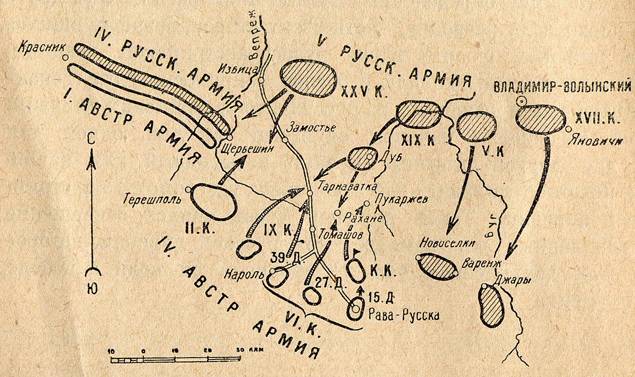
2 card. Austrian 4 and Russian 5 Army 10 - 13 August 1914
25-th korpuc subjected to a frontal impact of the Austro-Hungarian 4-th division and strike from the flank by 13-rd and 25-th divisions and 13-14 of August in the area of Zamosc was defeated (the Austrians announced more than 20 seized guns and remnants the retreating regiments of the 3 Grenadier Division numbered the 4274 man, that is, the division lost up to ¾ composition). August 14 The 25 Corps retreated to Krasnostav.
On August 13-14, the 19 and 5 army corps fought to prevent the advancing enemy. The actions of these compounds made it possible for the 25 corps to detach from the enemy at 20 km.
The 19 Corps fulfilled the most important task - it opposed parts of the 6 and 9 Army Corps and Vitman Cavalry Corps. The battles of 13-14 in August at Tarnavatka were successful (the 39-division of the enemy left the Russians up to 1,3 thousands of prisoners, 2 guns and 5 machine guns). M. Auffenberg defined the loss of the 39 Division as equal to 50% [Auffenberg-Komarow M. von. Aus Österreichs höhe und niedergang; eine lebensschilderung. Műnchen, 1921. S. 296.]. Russian losses - over 2 thousand people.
August 14 Russian 17-I and 38-I divisions repulsed enemy attacks and captured up to a thousand prisoners. In the battles of August 15 also managed to repel all enemy attacks. And the 19 corps repeatedly turned into counterattacks, retaining its position, capturing several hundred prisoners and 1-2 guns.
Nevertheless, despite the tactical victories, the situation was difficult. The retreat of the 25 Corps created an 25-kilometer gap between it and the 19-corps. The last flanks were open. Fearing for the rear of the 19 Corps, P. A. Plehve on August 15 ordered the 25 Corps to advance on Zamost, to divert the Austrians.
At the same time, the 5 and 17 corps of the 5 army, despite the fact that they succeeded, defeating the Austro-Hungarian 10 cavalry division, to go to the rear of the entire 4 army [The Austrians wrote about this: “This division underwent a sudden attack of infantry or dismounted cavalry (Cossacks) in the dawn ... As a result, the division fled. Only her horse artillery along with horse artillery 6-th Kav. The divisions managed to counteract and cover the running horsemen. The composition of 10-th Kaval. divisions were very good shelves, which subsequently proved to be excellent. Golovin N.N. Iz stories 1914 campaigns on the Russian front. Galician battle. The first period. C. 279.]), impacted by the rescued group of the Archduke Joseph Ferdinand.
The army, having suffered failure on the flanks, got into a difficult situation: it turned out to be divided into battle groups, and the 19 corps, remaining alone, fought against the enemy's 3 corps, which attacked it from all directions. In his memoirs, M. Auffenberg wrote that he had decided on a wide double coverage of Russians north of Tomashev - which almost led to Gangnam.
But in the new positions, P. A. Plehve consolidated the front, eliminating the dispersal of his troops (although for the present only in relation to the central corps). The left-handed 17 body was pulled closer to the 5, and thus managed to create a single group of three bodies. The right-flank 25 corps operated by Zamoć.
As a result, the 19 corps repelled the onslaught of the Austro-Hungarian 6 and 9 corps: the corps commander, Lieutenant General V. N. Gorbatovsky, with the help of an artillery maneuver, repulsed all enemy attacks, inflicting heavy losses on the enemy and holding positions. So, at the Austrian 27 division, 800 prisoners were captured. The Austrian 15 Division of the 6 Corps, moving to the rear of the 19 Corps, itself came under the flank attack of the Russian 10 Infantry Division (more than 15 thousand lost the enemy’s Laschnow) several thousand killed and wounded. prisoners, Russian trophies became 4 guns, the defeat of the division was preceded by the destruction of the 22-Bosnia-Herzegovina battalion - lost 1 people). Russian units lost at Lashhov for two days of the 915 battle of a man.
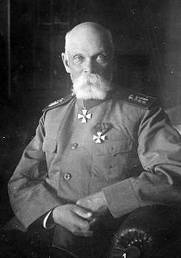
23. The hero of the Tomashevsky battle - General of Infantry VN Gorbatovsky
On the flanks of P.A. Pleve’s army, the difficult situation remained: the 25 corps maintained a significant gap with the central corps group (withdrawal from Krasnostav allowed the Austrians to bypass it from the north), and the 17 corps of August 15 was attacked in the flank by Austro-Hungarians ( Joseph Ferdinand's group) and retreated. For example, the losses of the 35 division in a battle at Tarnoshin amounted to more than 1100 people and 18 guns. The most affected 137 infantry regiment Nezhinsky lost up to 70-80% of the personnel. The Austrians used armored cars - and the regiments of the 61 division began to retreat to Staroye Selo. 61-I artillery crew, reflecting the enemy attack, shot all the shells, suffered heavy losses in the calculations and left 40 guns on the battlefield (16 of them captured the 1 Tyrolean regiment). 61 Division I lost 21 machine gun from 32 [White A. Galicia battle. C. 124].
3 card. The contours of the Battle of Galicia. Austrian map. Dates - a new style.
By the evening of August 15 9,5 infantry and 3 cavalry divisions of the army P. A. Plehve fought 12 infantry and 3 cavalry divisions of M. Auffenberg.
24. Austrian lancers.
The catastrophe of the central group of the 5 Army (5 and 19 buildings) of the “Samson” type loomed — the flanking corps (17 and 25) were defeated. The Austro-Hungarian 2 Corps carried out a deep bypass of the right flank of the central group. And in the 5 center, the Russian divisions (2 - 19, 2 - 5, and 1 - 17 units) opposed the 7,5 infantry divisions of the Austrian 6, 9, and 17 units. On the left flank, a Joseph Ferdinand division’s 3 maneuver was performed. To the east, units of the Austro-Hungarian 2 Cavalry Division were moving.
25. Austrian field battery in battle.
And by the evening of August 17, the situation seemed hopeless - M. Auffenberg put into practice the next beloved Austro-Germanic Cannes. The rear road of the 19 Corps was already under Austrian fire. The Russian corps on the 60-65-km front were covered by a semi-ring - and in order to close the ring, it was necessary to go no more than a transition (1-2 efforts of days).
But the success of the Russian southern armies (3 and 8), and, most importantly, the energetic and solid P.A. Pleve, was not A.V. Samsonov.
On August 17, the commander ordered the 25 Corps to take control of Zamo г.ć (by easing the position of the 19 Corps), knock out the enemy from Krasnostava and close the path to the Hill, and the 5, 17, and 19 corps were given the order back. " P. A. Plehve ordered his commors to act energetically and actively use artillery.
And although the battles for the town of Krasnostav ended in vain for the Russians (after the fire strike the Austrian 45 division advanced to Krasnostava, capturing more than 1 thousand prisoners, the city itself was occupied by the Austrian 24 division), leading the 19 corps, leading active defense and efficiently operating with reserves, acted successfully.
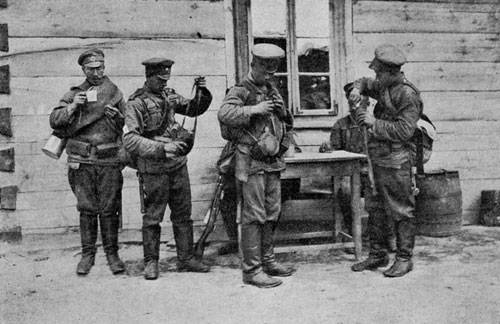
26. Galicia. Soldiers are stocking up water in the bins (photo piece-cap. Korsakov).
The cavalry in reserve (the 10 Don Cossack Regiment) took part in counterattacks against the Austrians and reached enemy artillery and took the gun and charging boxes (16 August). On the same day, Komarov was captured before the Austrians by 800 in a battle. On August 18, during the battles under the Oak, 3 Cossack batteries suddenly opened fire, shooting infantry and 5 enemy batteries. And then the 1-I Don Cossack Division captured 6 light guns, 4 howitzers and up to 350 prisoners.
27. Cossacks in the campaign.
The 19 Corps counterattack (by the time the most significantly bypassed by the enemy) 18 August has improved the situation. The compound, having shown combat stability, bound the 2,5 of the Austro-Hungarian corps, easing the situation on the front of the entire army. But the five-day continuous battle is very tired corps. The losses were very large: in the companies left on the 30-100 fighters (instead of 250), the command staff was knocked out. But the losses of the enemy were also great - for example, the composition of the enemy's 26 division consisted of only 35% of the regular strength.
The neighboring 5 Corps also led successful battles with parts of the Austro-Hungarian 6 Corps. 17-th corps repelled enemy attacks.
5-I army suffered heavy losses. In particular, the 17 and 38 divisions of the 19 corps had an average shortage of 25-30 officers and 2000 soldiers per regiment (i.e., losses up to 50-60%) [White A. Galicia battle. C. 145.].
Under these conditions, the commander adopted 18 on August, an operational decision to withdraw the army from enemy attacks - in order to regroup for further offensive.
A competent retreat maneuver was implemented under the cover of the rear guard and cavalry artillery fire: the army cavalry (1-I and 5-I Don Cossack divisions), in cooperation with the 25-corps, rejected the bypassing Austrian formations to Zamostyu, eliminating the threat of the environment. The Austro-Hungarian 2 Corps, bypassing the right flank of the 19 Corps, was hit in the rear. The divisions of the 2 corps in panic rushed back to Zamo, having lost 10 guns, the 5-I Don division captured more 400 prisoners and 2 machine guns. The forces of the enemy, bypassing the left flank of the army, were also rejected - Consolidated and 7-th cavalry divisions.
Thus, the 5 Army was able to break away from the enemy and safely withdraw to the north on the 3 transition. There was a regrouping. The departure was not a forced retreat, but a separation from the enemy in order to preserve the maneuverability [Golovin N. N. The Battle of Galicia. The first period. C. 505 .; He is. The days of the breakthrough of the Galician battle. C. 21].
The total losses of the 5 army during the Tomaszewski battles amounted to 30000 (including 10000 prisoners - mainly due to flanking corps), the "victorious" Austrian troops lost 40000 (including 20 thousand prisoners) people. The same figures were confirmed by the enemy. [Cm. Auffenberg-Komarow M. von. Aus Österreich-Ungarns Teilnahme am Weltkriege. S. 248.].
The losses were very significant, which characterized the stubbornness and military stability of the forces of both sides in the initial period of the war. The total loss of the 5 Army's infantry divisions was 40-50% of the composition. Thus, the main “birthday boy” of the Tomaszew Battle - 19 Corps - by the end of the first two days of the battle lost 7 thousand people (loss figures increased by the end of the fighting surrounded by only one 38 Division to 100 officers and 8 thousand soldiers, i.e. 35% command and 50% rank and file). But the trophies of the corps were great: 11 guns, 30 machine guns, up to 5 thousand prisoners.
The operation on the environment has turned into a repression - and the result did not justify the losses suffered by the Austrians.
14 card. Tomashevsky battle. 14 environment in August 1914
The plan of the Austrian command to encircle the Russian armies, which were able to forge the main enemy forces, was thwarted — this facilitated the rout of the Austro-Hungarian armies in the Lvov sector.
Nevertheless, the general situation on the northern flank of the battle is not in favor of the Russians - and the 4 and 5 armies suffered setbacks.
During the Lublin-Kholmsky battle, the Russian 4 Army in 10-13 battles with the troops of the Austrian 1 Army suffered a tactical defeat and retreated to Lublin, where 14-20-August was entrenched, successfully repelled the enemy’s attacks.
The Russian 5 Army during the Tomaszewski battle fell into a more difficult situation, and a number of its units were also defeated. But 5-I army escaped defeat and put herself in order, moving to the north and carrying out a regrouping. The withdrawal returned to the army the freedom of maneuver. 4-I army bravely defended at Lublin, fresh troops arrived on its flank, and gradually the advantage in this area went to the Russian. Redeployed reserves are structured in the form of a new 9 army under the command of P. A. Lechitsky. In this situation, the blow of the Germans from East Prussia to Sedlec could fundamentally turn the tide and lead to the disaster of the South-Western Front, but this did not happen.
The most important thing is that the 4 and 5 armies of the Southwestern Front managed to avoid the operational environment. Moreover, it gave the Russian command a gain in time, which was of paramount operational importance - after all, the priority during the “martyr” of the Galician battle was when success was achieved faster: from the actions of the Austro-Hungarian armies in the northern flank of the battle or the Russian 1-th and 4-th armies - on the south.
To be continued
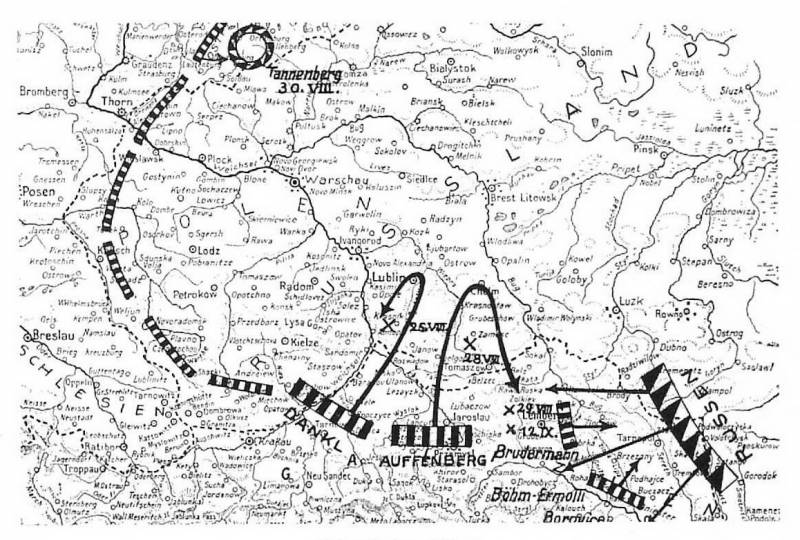
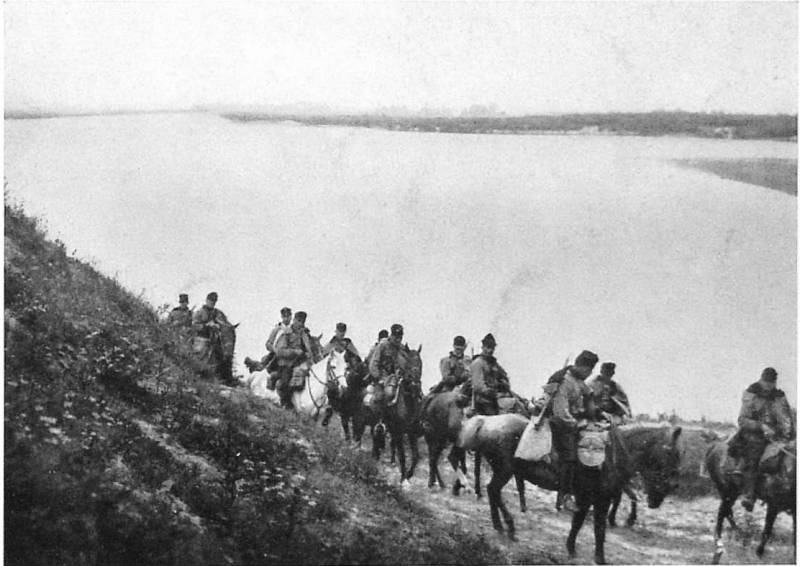
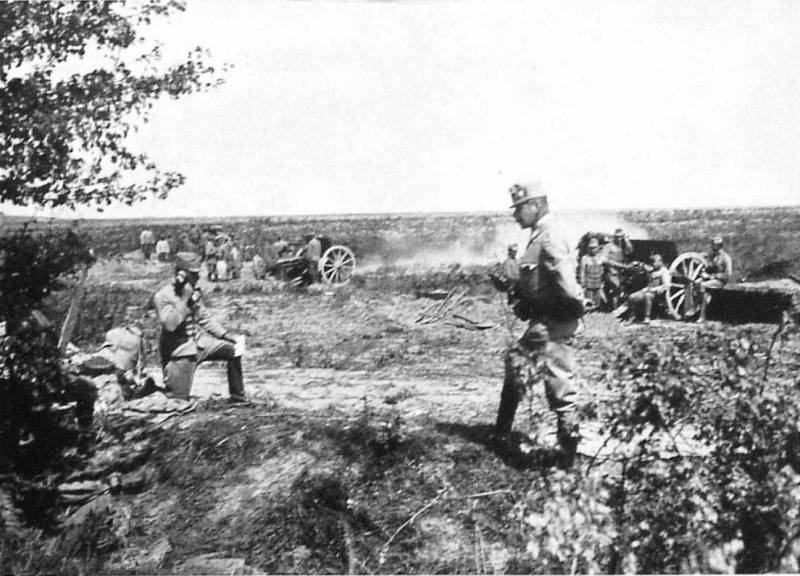
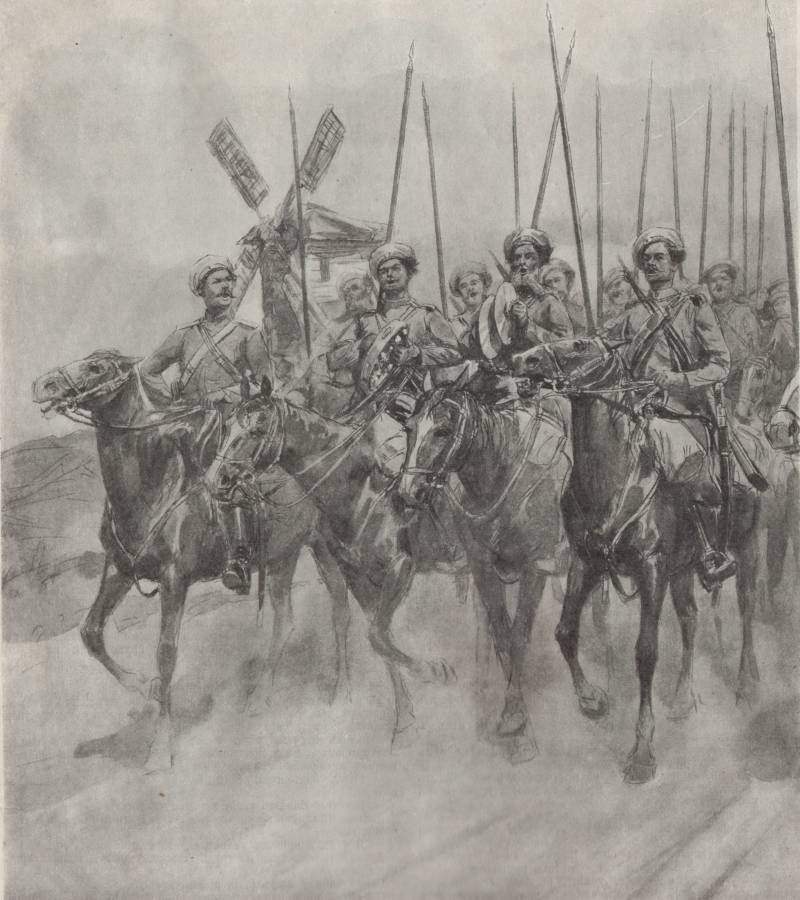
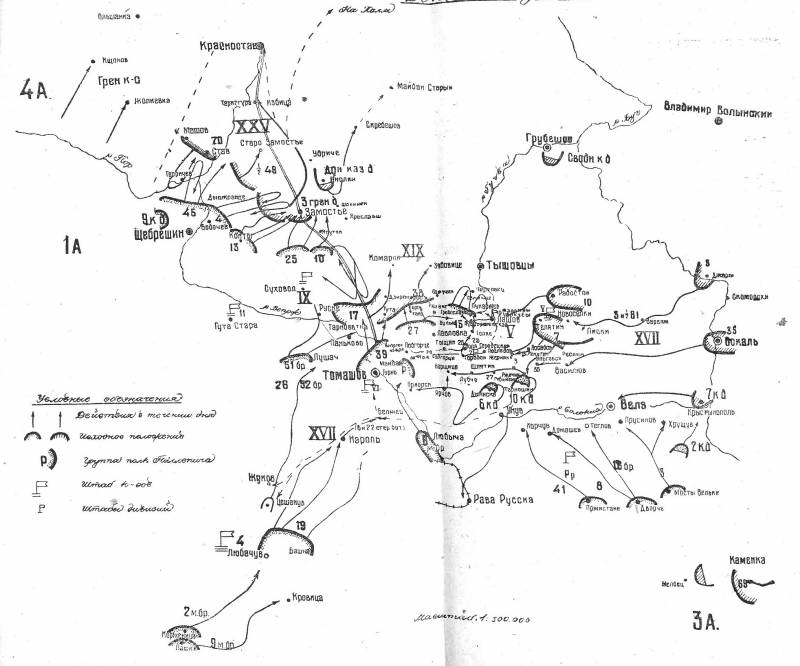
Information